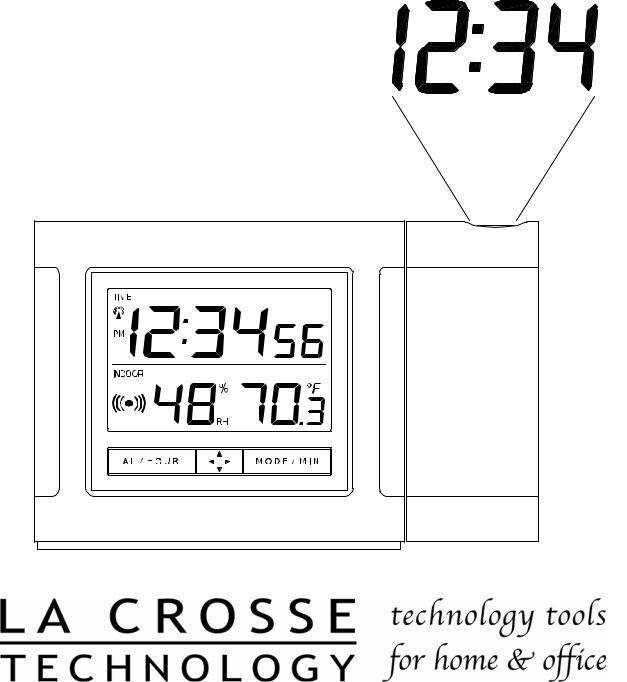La Crosse Technology WT-5110U User Manual

WT-5110
433 MHz
Radio Controlled Projection Alarm
Instruction Manual
TABLE OF CONTENTS
Topic |
Page |
Inventory of Contents/ Additional Equipment |
3 |
About WWVB |
3 |
Quick Set-Up Guide |
4 |
|
|
Detailed Set-Up Guide |
|
Battery Installation |
5 |
Program Mode |
|
Programming Sequence |
6 |
Function Buttons |
6 |
Manual Time Setting |
6 |
Time Zone Setting |
6-7 |
Daylight Saving Time (DST) Setting |
7 |
|
|
Features & Operations |
|
Features |
8 |
Radio-Controlled Time |
8 |
Projection |
8 |
LED Backlight |
9 |
Indoor Temperature |
9 |
Indoor Humidity |
9 |
Time Alarm |
9 |
Changing Display Mode |
10 |
Maintenance & Care |
10 |
Troubleshooting |
10 |
Specifications |
11 |
Warranty and Contact Information |
12-13 |
2
INVENTORY OF CONTENTS
1)WT-5110 Alarm Clock
2)AC adapter/transformer
3)Instruction manual and warranty card.
ADDITIONAL EQUIPMENT (not included)
1)Two fresh 1.5V AA batteries (optional for projection alarm clock)
FEATURES OF PROJECTION ALARM
Operation of these features is in section III
1.Radio-controlled time
2.Projection of time
3.LED backlight
4.Display of indoor temperature/humidity or alarm time
5.Time alarm
ABOUT WWVB (Radio Controlled Time)
The NIST (National Institute of Standards and Technology—Time and Frequency Division) WWVB radio station is located in Ft. Collins, Colorado, and transmits the exact time signal continuously throughout the United States at 60 kHz. The signal can be received up to 2,000 miles away through the internal antenna in the projection alarm. However, due to the nature of the Earth’s Ionosphere, reception is very limited during daylight hours. The projection alarm will search for a signal every night when reception is best.
The WWVB radio station receives the time data from the NIST Atomic clock in Boulder, Colorado. A team of atomic physicists is continually measuring every second, of every day, to an accuracy of ten billionths of a second per day. These physicists have created an international standard, measuring a second as 9,192,631,770 vibrations of a Cesium-133 atom in a vacuum. For more detail, visit http://www.boulder.nist.gov/timefreq.htm. To listen to the NIST time, call (303)499-7111. This number will connect you to an automated time, announced at the top of the minute in “Coordinated Universal Time”, which is also known as Greenwich Mean Time (GMT). This time does not follow Daylight Saving Time changes. After the top of the minute, a tone will sound for every second. It is possible that your projection alarm may not be exactly on the second due to the variance in the quartz. However, the clock will adjust the quartz timing over the course of several days to be very accurate; under 0.10 seconds per day.
3
QUICK SET-UP GUIDE
Hint: Use good quality Alkaline Batteries and avoid rechargeable batteries.
1.We recommend beginning the set-up procedure at night when the WWVB signal is easiest to receive.
2.It is also highly recommended to set the projection alarm in a window or other area free of interference in the area of your home that is closest to Colorado (the source of the WWVB signal).
NOTE: The above steps are not required but can help the projection alarm receive the signal faster.
3.Place the batteries into the projection alarm clock.
4.DO NOT PRESS ANY BUTTONS FOR 15 MINUTES.
NOTE: It is important to not press any buttons after inserting batteries as this will interrupt the WWVB search sequence.
In this time the display will show both the indoor temperature and humidity. If the station does not display both indoor temperature and indoor humidity after the 15 minutes please retry the set up as stated above. After both indoor temperature and indoor humidity are displayed for 15 minutes you can place your projection alarm in your desired location.
To complete the set up of your temperature station after the 15 minutes have passed please follow the steps beginning on page 6.
4
